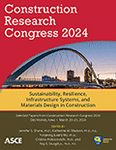Concurrent Modeling of Embodied Carbon and Construction Costs for Mass Timber Construction
Publication: Construction Research Congress 2024
ABSTRACT
Construction product manufacturing is a contributor to global climate change through its carbon emissions, known as embodied carbon (EC). Previous studies have found that utilizing a mass timber structural system can contribute to a reduction of EC. A barrier that prevents the use of mass timber is its higher cost than other available alternatives, which should be justified by stakeholders that wish to use mass timber. However, there is a dearth of studies to support their efficient analysis and decision making. To fill this knowledge gap, the objective of the present study is to develop a model which streamlines a decision-making process based on cost and EC data. To test the model, a case study was performed to compare the costs and EC of multiple structures. Based on the case study, the model proved to be an efficient way of providing the desired data. Additionally, the study found that alternatives utilizing mass timber resulted in a larger percentage reduction in EC than increase in cost. The model is expected to support stakeholders that wish to lower EC by selecting a mass timber structure.
Get full access to this article
View all available purchase options and get full access to this chapter.
REFERENCES
AACE (Association for the Advancement of Cost Engineering). (2020). “Cost Estimate Classification System – As Applied in Engineering, Procurement, and Construction For The Process Industries.” https://web.aacei.org (May 15, 2023).
Balali, V., Zahraie, B., and Roozbahani, A. (2014). “Integration of ELECTRE III and PROMETHEE II Decision-Making Methods with an Interval Approach: Application in Selection of Appropriate Structural Systems.” J. Comput. Civ. Eng., 28(2), 297–314. https://doi.org/10.1061/(ASCE)CP.1943-5487.0000254.
Balali, V., Zahraie, B., and Roozbahani, A. (2014). “Integration of ELECTRE III and PROMETHEE II Decision-Making Methods with an Interval Approach: Application in Selection of Appropriate Structural Systems.” J. Comput. Civ. Eng., 28(2), 297–314. https://doi.org/10.1061/(ASCE)CP.1943-5487.0000254.
Chen, W. F., Lui, E. M., Chen, W., and Lui, E. (2005). Principles of Structural Design. CRC Press. Baton Rouge, LA.
Crawford, R. H., and Cadorel, X. (2017). “A Framework for Assessing the Environmental Benefits of Mass Timber Construction.” Procedia Eng., 196, 838–846. https://doi.org/10.1016/j.proeng.2017.08.015.
Davies, A., Gann, D., and Douglas, T. (2009). “Innovation in Megaprojects: Systems Integration at London Heathrow Terminal 5.” California Management Review, 51(2), 101–125. https://doi.org/10.2307/41166482.
Dodoo, A., Gustavsson, L., and Sathre, R. (2014). “Lifecycle carbon implications of conventional and low-energy multi-storey timber building systems.” Energy Build., 82, 194–210. https://doi.org/10.1016/j.enbuild.2014.06.034.
Dysert, L. (2007). “Is Estimate Accuracy an Oxymoron?” Cost Engineering (Morgantown, W. Va.) 49 (1), 32–.
Gelowitz, M. D. C., and McArthur, J. J. (2018). “Insights on environmental product declaration use from Canada’s first LEED® v4 platinum commercial project.” Resour. Conserv. Recycl., 136, 436–444. https://doi.org/10.1016/j.resconrec.2018.05.008.
Holm, L., and Schaufelberger, J. (2021). Construction Cost Estimating. Routledge/Taylor & Francis Group. New York, NY.
Ibn-Mohammed, T., Greenough, R., Taylor, S., Ozawa-Meida, L., and Acquaye, A. (2013). “Operational vs. embodied emissions in buildings—A review of current trends.” Energy Build., 66, 232–245. https://doi.org/10.1016/j.enbuild.2013.07.026.
IEA (International Energy Agency). (2019). “Global Status Report for Buildings and Construction.” https://www.iea.org/reports/global-status-report-for-buildings-and- construction-2019 (April 23, 2023).
ISO. (2006). “Environmental labels and declarations - Type III environmental declarations - Principles and procedures.” https://www.iso.org/obp/ui#iso:std:iso:14025:ed-1:v1:en (April 23, 2023).
Pierobon, F., Huang, M., Simonen, K., and Ganguly, I. (2019). “Environmental benefits of using hybrid CLT structure in midrise non-residential construction: An LCA based comparative case study in the U.S. Pacific Northwest.” J. Build. Eng., 26, 100862–. https://doi.org/10.1016/j.jobe.2019.100862.
Polat, G., Turkoglu, H., and Damci, A. (2018). “Structural System Selection Using the Integration of Multi-Attribute-Decision-Making (MADM) Methods.” Periodica Polytechnica. Architecture, 49(1), 38–46. https://doi.org/10.3311/PPar.12670.
Rodriguez, B. X., Huang, M., Lee, H. W., Simonen, K., and Ditto, J. (2020). “Mechanical, electrical, plumbing and tenant improvements over the building lifetime: Estimating material quantities and embodied carbon for climate change mitigation.” Energy Build., 226, 110324–. https://doi.org/10.1016/j.enbuild.2020.110324.
Skullestad, J. L., Bohne, R. A., and Lohne, J. (2016). “High-rise Timber Buildings as a Climate Change Mitigation Measure – A Comparative LCA of Structural System Alternatives.” Energy Procedia, 96, 112–123. https://doi.org/10.1016/j.egypro.2016.09.112.
Su, S., Li, X., Zhu, C., Lu, Y., and Lee, H. W. (2021). “Dynamic Life Cycle Assessment: A Review of Research for Temporal Variations in Life Cycle Assessment Studies.” Environ. Eng. Sci., 38(11), 1013–1026. https://doi.org/10.1089/ees.2021.0052.
Waldman, B., Huang, M., and Simonen, K. (2020). “Embodied carbon in construction materials: a framework for quantifying data quality in EPDs.” Buildings & Cities, 1(1), 625–636. https://doi.org/10.5334/bc.31.
World GBC (World Green Building Council). (2019). “Brining embodied carbon upfront” https://worldgbc.org/advancing-net-zero/embodied-carbon/ (May 15, 2023).
Yin, R. K. (2014). Case Study Research: Design and Methods. SAGE. Thousand Oaks, CA.
Information & Authors
Information
Published In
History
Published online: Mar 18, 2024
Authors
Metrics & Citations
Metrics
Citations
Download citation
If you have the appropriate software installed, you can download article citation data to the citation manager of your choice. Simply select your manager software from the list below and click Download.
